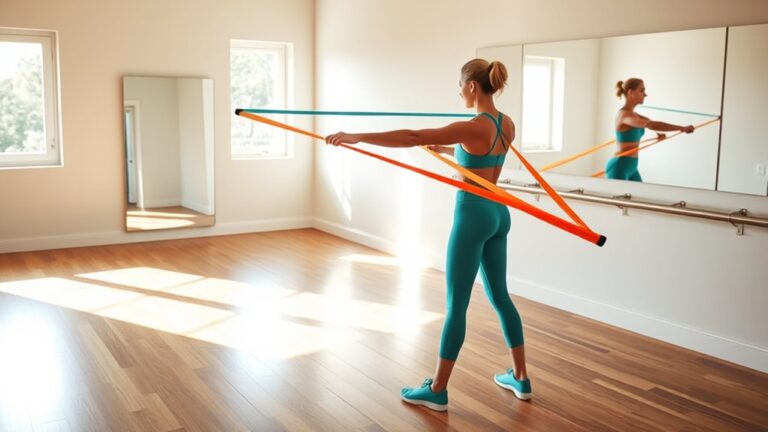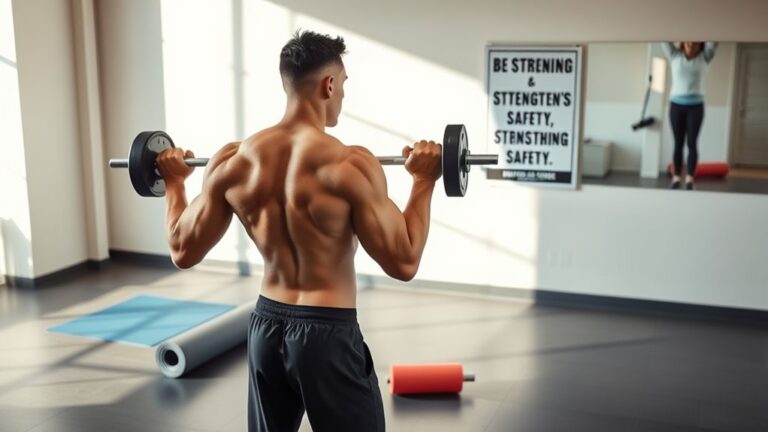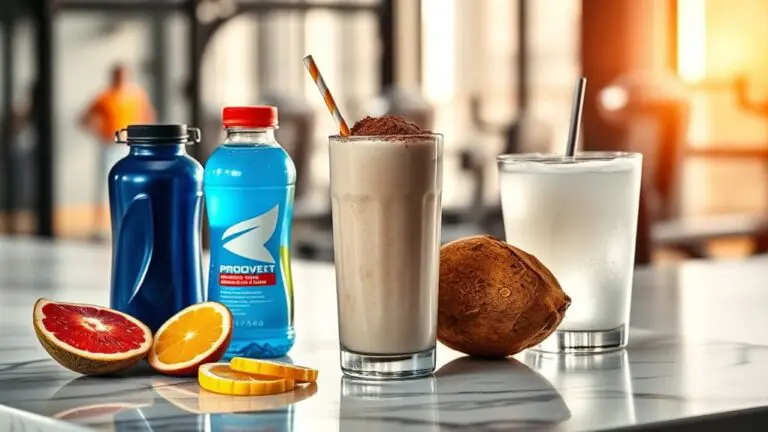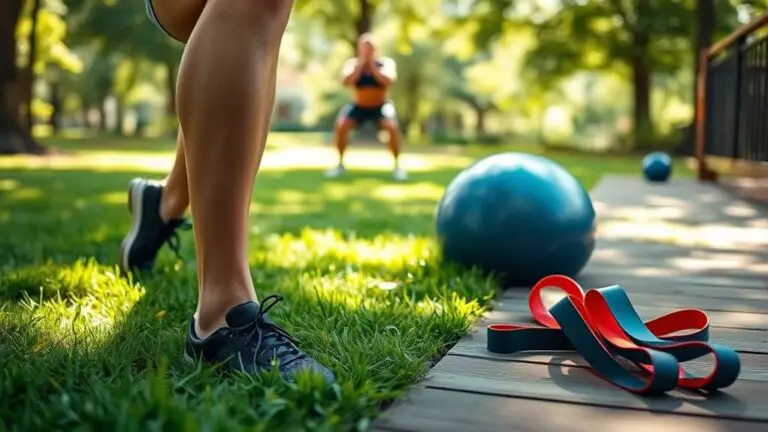The Best Foam Rollers for Post-Workout Recovery
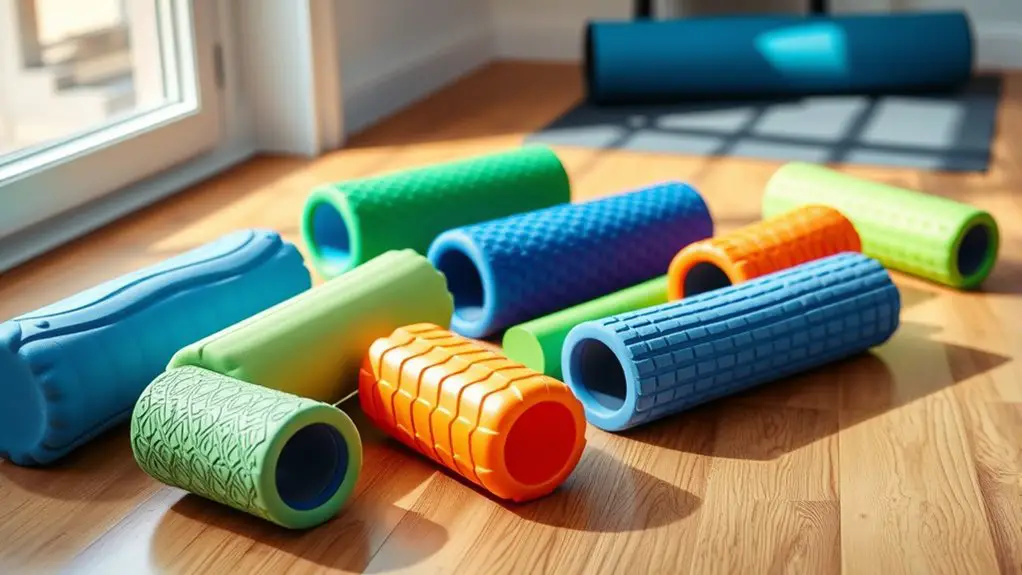
For post-workout recovery, high-density foam rollers are ideal for effectively alleviating muscle soreness and enhancing flexibility. Vibrating foam rollers can further improve blood flow and target deep muscle tension. If you’re traveling, compact and lightweight options work well without taking up much space. Remember to choose based on your comfort level and specific needs. Consistent use can greatly boost your recovery routine. Keep exploring to discover more about selecting the perfect foam roller for yourself!
Understanding Foam Rolling and Its Benefits
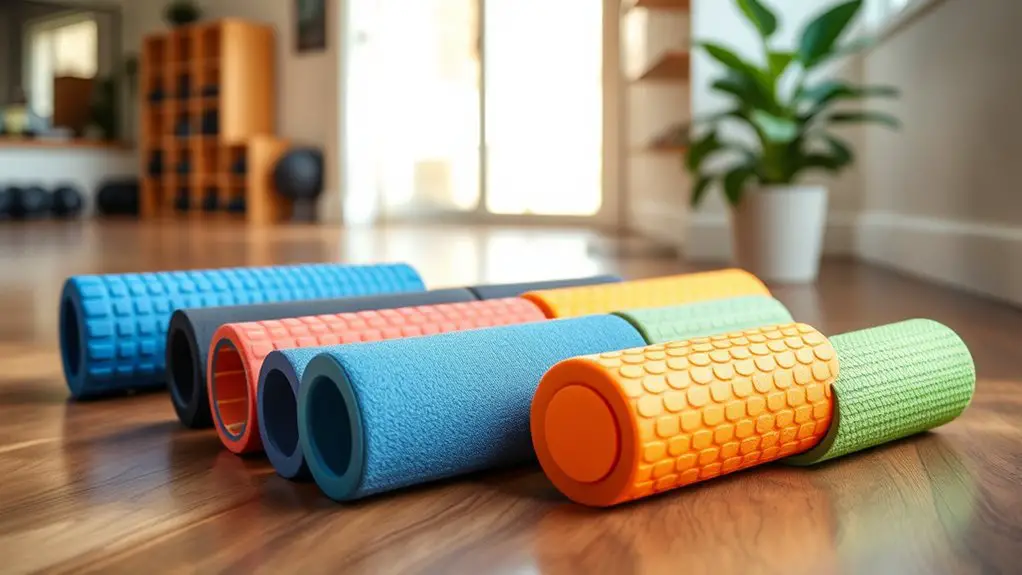
Foam rolling is a simple yet powerful technique that can greatly enhance your recovery routine. By incorporating foam rolling techniques into your post-workout regimen, you can experience a range of muscle recovery benefits. This method involves using a foam roller to apply pressure to sore or tight muscles, promoting blood flow and helping to release tension.
When you roll over specific muscle groups, you’re fundamentally performing self-myofascial release, which can alleviate muscle soreness and improve flexibility. Plus, this practice can enhance your overall performance by preparing your muscles for future workouts.
Whether you’re an athlete or just starting your fitness journey, foam rolling can be a game changer. It’s an effective way to speed up recovery and keep your muscles functioning at their best. So, grab that foam roller and start reaping the benefits!
Types of Foam Rollers
When choosing a foam roller, you’ll find various densities to match your comfort and recovery needs. Additionally, they come in different shapes and sizes, making it easier to target specific muscle groups. Understanding these options can help you select the perfect roller for your routine.
Density Variations Explained
Understanding the different density variations in foam rollers is essential for maximizing your recovery routine. Foam density plays a significant role in how effectively a roller can alleviate muscle soreness. Generally, you’ll find softer rollers, which are great for beginners or those with sensitive muscles, and firmer options, designed for more intense pressure and deeper tissue work.
If you’re looking for a gentle massage, choose a low-density roller; it’ll be easier on your muscles. On the other hand, if you want to target tight spots and knots, opting for higher roller firmness can provide the necessary pressure. By selecting the right foam density, you can tailor your recovery experience to meet your specific needs, ensuring ideal results.
Shapes and Sizes Available
There are several shapes and sizes of foam rollers designed to meet various recovery needs and preferences. You’ll find traditional cylindrical rollers, which are perfect for general muscle relief. If you’re looking for targeted pressure, consider using shorter, half-moon shapes that fit nicely into your hand. There are also unique designs, like the peanut roller, which focuses on areas like the spine. When it comes to sizes, foam rollers range from compact 12-inch options for travel to longer 36-inch rollers for broader coverage. Choosing the right shape and size can enhance your recovery experience, allowing you to address specific muscle groups effectively. So, think about your workout routine and personal preference before making a choice!
Best High-Density Foam Rollers
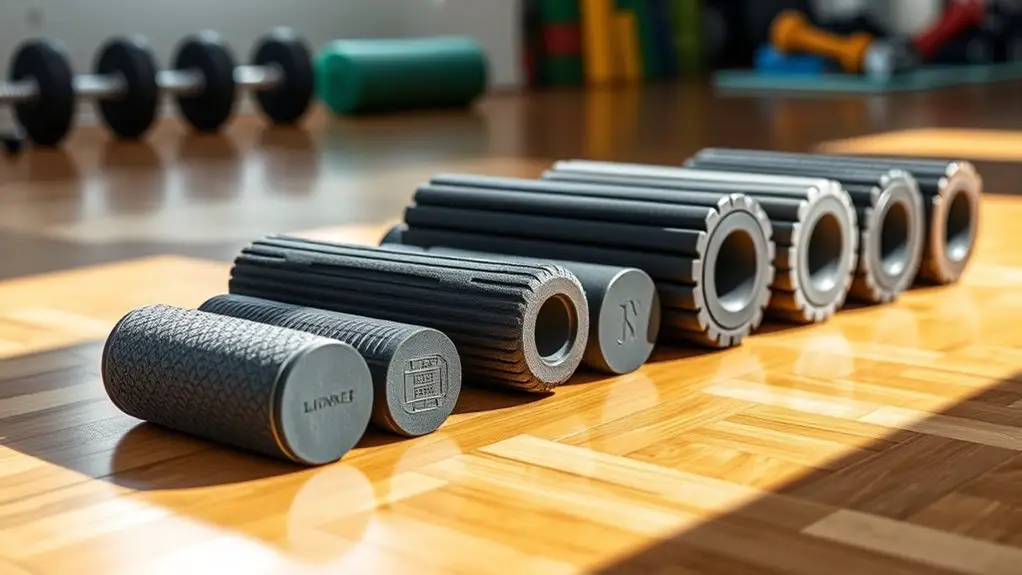
If you’re serious about recovery and muscle maintenance, high-density foam rollers are a game-changer. These rollers provide the firmness needed to deeply penetrate muscle tissue, helping to alleviate soreness and enhance flexibility. One of the key high-density benefits is their durability; they maintain their shape over time, unlike lower-density options that can compress quickly.
When you look at foam roller comparisons, you’ll find that high-density models often outperform others regarding effectiveness and longevity. They’re perfect for athletes and fitness enthusiasts who need reliable muscle relief after intense workouts.
Whether you’re targeting tight hamstrings or sore back muscles, a high-density foam roller can help you recover faster and perform better. Investing in a quality high-density foam roller is a smart choice for anyone serious about optimizing their post-workout routine.
Best Vibrating Foam Rollers
If you’re looking to enhance your recovery routine, vibrating foam rollers might be the perfect addition. They offer unique benefits like improved blood flow and reduced muscle soreness, making your post-workout routine even more effective. Let’s explore some of the top vibrating options available and how to use them for maximum benefit.
Benefits of Vibration
While traditional foam rollers are effective for muscle recovery, incorporating vibration can elevate your experience to a whole new level. Vibration benefits include increased blood flow, which helps deliver essential nutrients to your muscles and aids in faster recovery. By using a vibrating foam roller, you’ll not only alleviate muscle soreness but also enhance the release of tight fascia and knots, promoting overall flexibility. The vibrations can stimulate your nervous system, making it easier to relax and unwind after an intense workout. Additionally, the combination of pressure and vibration can help you target specific areas more effectively, allowing for deeper tissue work. So, if you’re serious about optimizing your recovery, a vibrating foam roller might be just what you need.
Top Vibrating Options
When it comes to enhancing your recovery routine, choosing the right vibrating foam roller can make all the difference. These rollers are designed to increase blood flow and promote muscle recovery through varying vibration intensity levels. Look for options that allow you to customize the intensity to target specific muscle groups effectively.
Popular models like the Hyperice Vyper 2.0 and the RumbleRoller Vibrating Foam Roller are top choices among athletes. They combine the benefits of traditional foam rolling with advanced vibration technology, helping to alleviate soreness and improve flexibility. By integrating a vibrating foam roller into your post-workout regimen, you’re not just rolling out tight spots; you’re also reaping the rewards of enhanced recovery.
Usage Tips & Techniques
Integrating a vibrating foam roller into your recovery routine can greatly enhance its effectiveness, but knowing how to use it properly is key. Here are some tips to maximize your experience:
- Start slow: Begin with a lower intensity setting to allow your muscles to adjust before increasing the vibration.
- Focus on tight spots: Use it on areas that need myofascial release, such as your calves, quads, and back.
- Roll slowly: Move at a deliberate pace, spending 30-60 seconds on each muscle group to promote injury prevention.
- Combine with stretches: After rolling, follow up with static stretches to enhance flexibility and recovery.
Best Textured Foam Rollers
Looking for a way to enhance your recovery routine? Textured foam rollers might be just what you need. These rollers come with varying surface patterns that provide unique textured benefits, targeting muscle knots and tension more effectively than traditional smooth rollers. The raised bumps and ridges help stimulate blood flow and improve roller effectiveness, making them ideal for deep tissue massage.
When using a textured foam roller, you’ll notice how the different patterns can reach those hard-to-target areas, offering a more intense myofascial release. This increased pressure can lead to quicker recovery times and reduced muscle soreness after workouts.
Whether you’re looking to alleviate tightness in your back, legs, or shoulders, a textured foam roller can be your best friend in post-workout recovery. Invest in one, and you’ll likely see noticeable improvements in your overall performance and flexibility.
Best Travel-Friendly Foam Rollers
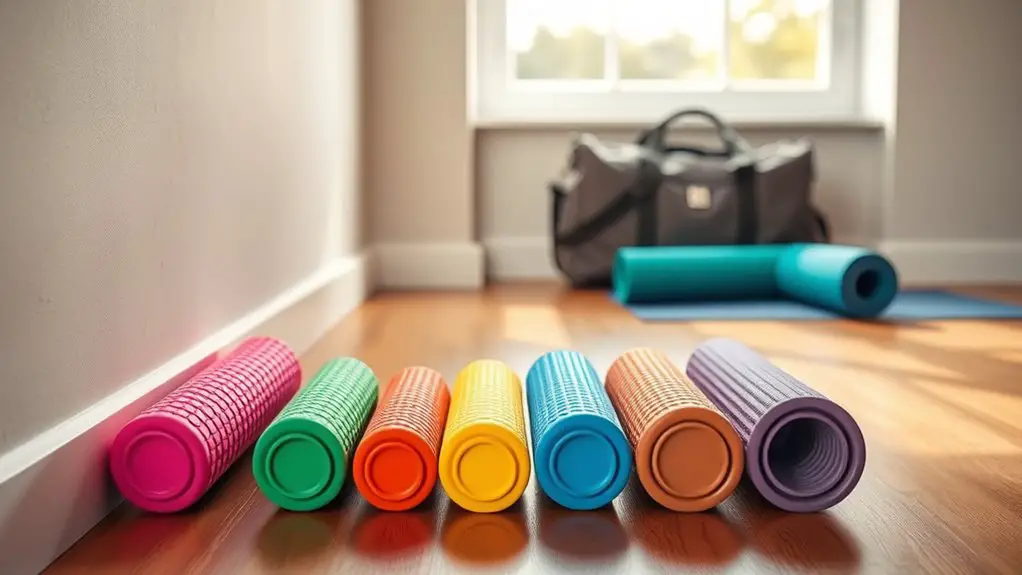
Textured foam rollers are fantastic for deep tissue massage, but what if you’re on the go? When you need effective recovery without the bulk, look for foam rollers that feature a compact design for travel convenience. Here are four top picks that’ll fit perfectly in your suitcase:
Discover compact foam rollers designed for travel, ensuring effective recovery without the bulk!
- TriggerPoint Grid Mini – This compact roller offers a unique grid pattern that mimics the feeling of a massage therapist’s hands, perfect for targeted relief.
- Liforme Foam Roller – Lightweight and portable, this roller is made from durable foam, ensuring it holds up during your travels.
- ProForm Foam Roller – Designed for easy packing, it provides great support and is ideal for both pre- and post-workout recovery.
- RumbleRoller Mini – With its smaller size and textured surface, it’s perfect for deep tissue work on the go.
With these options, you won’t have to sacrifice recovery while traveling!
How to Use a Foam Roller Effectively
While foam rolling might seem straightforward, using it effectively can greatly enhance your recovery routine. Start by identifying the muscle groups you want to target, like your quads, hamstrings, or back. Use slow, controlled movements to roll over each area, pausing on tender spots. This technique helps release tension and improve blood flow, maximizing muscle recovery benefits.
Aim for about 30 seconds to 1 minute per muscle group, adjusting pressure based on your comfort level. Experiment with different foam rolling techniques; for example, cross-friction rolling can help break up knots. Remember to breathe deeply to relax your muscles as you roll.
Incorporating foam rolling after workouts can considerably speed up recovery, reduce soreness, and increase flexibility. By making it a part of your routine, you’ll enjoy the full range of muscle recovery benefits foam rolling has to offer.
Tips for Choosing the Right Foam Roller
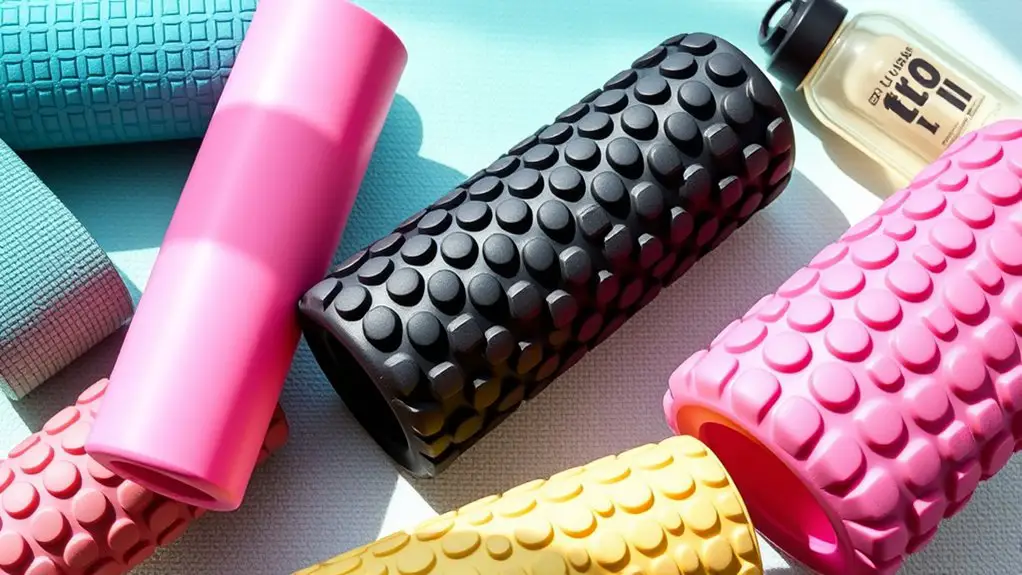
When you’re in the market for a foam roller, it’s essential to contemplate factors like density, size, and surface texture to find the best fit for your needs. Here are some tips to help you choose wisely:
- Density: Consider the firmness of the foam roller. Higher density options are great for deep tissue massage, while softer rollers are better for beginners.
- Size: Think about the length and diameter. A longer roller can cover more area, while a smaller one is easier to travel with.
- Surface Texture: Look at foam roller features like ridges or knobs. These can enhance your massage experience, targeting specific muscle groups.
- Foam Roller Materials: Choose high-quality materials for durability. EVA foam is popular for its resilience, while PVC is often more affordable.
Incorporating Foam Rolling Into Your Routine
Finding the right foam roller is just the beginning; incorporating foam rolling into your routine can greatly enhance your recovery and performance. Start by setting aside a few minutes after your workouts for this essential practice. The foam rolling benefits include improved flexibility, reduced muscle soreness, and increased blood flow, all important for effective recovery.
To integrate recovery seamlessly, try rolling out your muscles while watching TV or warming up before your workout. Focus on high-tension areas like your calves, quads, and back, applying pressure for 30-60 seconds on each area. It might be a bit uncomfortable at first, but that’s a sign it’s working!
Consistency is key—aim to foam roll at least three times a week. By making it a regular part of your regimen, you’ll not only feel the difference but also notice enhanced performance in your workouts. Embrace this simple tool as a significant part of your fitness journey!
Frequently Asked Questions
Can Foam Rolling Help With Muscle Soreness After Workouts?
Absolutely, foam rolling can be a game-changer for muscle soreness after workouts. By using a foam roller, you’re promoting muscle recovery and enhancing blood flow, which helps reduce pain relief and stiffness. This self-myofascial release technique can break up tight knots in your muscles, making you feel more relaxed and agile. So, if you’re looking to speed up your recovery and ease soreness, incorporating foam rolling into your routine is definitely worth it!
How Often Should I Use a Foam Roller?
You should aim for a foam rolling frequency of about 2-3 times a week for effective muscle recovery. Incorporating it into your post workout routine can enhance flexibility and reduce soreness. Spend around 10-15 minutes each session, focusing on major muscle groups like legs and back. If you’re feeling particularly tight, don’t hesitate to roll more often; just listen to your body and adjust accordingly for the best results.
Is Foam Rolling Safe for Everyone?
Imagine traversing a winding road—each twist and turn reflects your unique journey. Foam rolling can be safe for many, but individual health and injury history play essential roles. If you’ve got specific conditions or past injuries, it’s wise to consult a professional. Just like a skilled navigator adjusts their route, you should listen to your body and proceed cautiously. Embrace foam rolling, but always prioritize your well-being on this path to recovery.
Can Foam Rolling Improve Flexibility?
Yes, foam rolling can improve flexibility! By incorporating various foam rolling techniques, you can target tight muscles and fascia, promoting better range of motion. Regularly using a foam roller helps release tension and increase blood flow, which contributes to flexibility benefits. Just remember to roll slowly over tight areas and hold pressure for a few seconds to maximize the effects. With consistency, you’re likely to notice significant improvements in your flexibility over time!
What Should I Avoid While Foam Rolling?
Imagine maneuvering through a forest; you wouldn’t want to trip over roots. Similarly, while foam rolling, avoid common mistakes like rushing or applying too much pressure. Instead, embrace gentle foam rolling techniques that allow your muscles to relax. Don’t roll over bony areas or injuries, as this can cause more harm than good. By steering clear of these pitfalls, you’ll guarantee a smoother journey toward recovery and flexibility.
